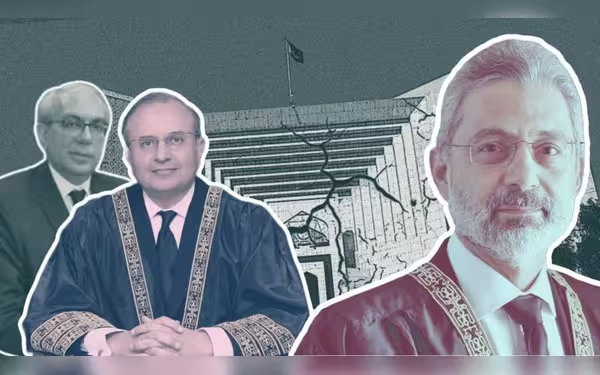Saturday, November 16, 2024 09:49 PM
Supreme Court Bench Controversy: Legality of Committee's Formation Under Scrutiny
- Supreme Court's bench formation raises constitutional concerns.
- Absence of Justice Mansoor Ali Shah complicates committee operations.
- Legal experts debate quorum requirements for bench decisions.
 Image Credits: thefridaytimes
Image Credits: thefridaytimesThe Supreme Court of Pakistan faces scrutiny over bench formation legality amid internal conflicts and constitutional debates.
The ongoing turmoil within the Supreme Court of Pakistan has raised significant concerns regarding the constitutionality of its bench formation. As tensions escalate among senior judges, questions arise about the legality of benches constituted by a three-member committee when one member is absent. This situation has sparked a heated debate among legal experts and constitutional scholars.
Recently, the bench-fixing committee, operating without Justice Mansoor Ali Shah, reconstituted a five-judge bench led by Chief Justice Qazi Faez Isa. This bench is set to hear a review petition concerning the Supreme Court's 2022 ruling on the defection clause outlined in Article 63-A of the Constitution. The Practice and Procedure Act (PPA) 2023, particularly after its recent amendment via a Presidential Ordinance, mandates that Justice Mansoor Ali Shah, as the senior puisne judge, must attend committee meetings. However, the law does not clarify the implications of his absence.
According to Section 2 of the PPA, every case before the Supreme Court should be heard by a bench formed by the committee, which includes the Chief Justice, the next most senior judge, and another judge nominated by the Chief Justice. Yet, the law remains silent on the procedure to follow if the senior-most judge is unavailable. Legal experts are turning to sub-section 3 of Section 2, which states that decisions can be made by a majority, suggesting that a quorum of two judges may suffice.
Constitutional expert Hafiz Ahsan Khokhar argues that the presence of two judges is adequate for the committee to function, asserting that any decisions made under these circumstances would be lawful. Conversely, Advocate Umer Gillani contends that the absence of a minimum quorum provision implies that the committee can only operate with all three members present. He criticizes the drafting of the PPA and the amending Ordinance, stating that it creates confusion and ambiguity regarding the committee's operations.
Advocate Mian Daud warns that if the critics' stance is accepted, it could render the Supreme Court inactive. He emphasizes that the Chief Justice has the discretionary power to issue administrative orders to ensure the court continues to function, especially when the law is unclear. This highlights the delicate balance between legal interpretation and the practical functioning of the judiciary.
As the controversy unfolds, the five-judge bench, led by Chief Justice Qazi Faez Isa, has resumed hearings on the review petitions. During the proceedings, the Chief Justice addressed the bench's constitution, revealing that Justice Akhtar was firm on his earlier stance regarding his presence. The Chief Justice also noted that Justice Shah's refusal to attend the committee meeting unless his conditions were met led to the inclusion of Justice Naeem Akhtar Afghan in his place.
This ongoing situation underscores the complexities and challenges faced by the Supreme Court in maintaining its integrity and functionality. The ambiguity surrounding the PPA and the recent amendments raises critical questions about the future of judicial proceedings in Pakistan. As the legal community grapples with these issues, it is essential to ensure that the Supreme Court remains a robust institution capable of upholding justice and the rule of law, even amidst internal strife.













